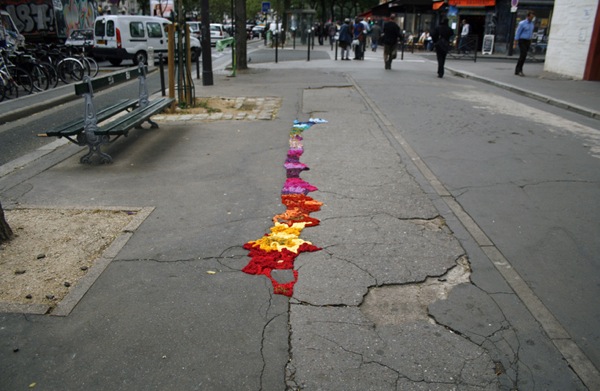The joy of swimming pools
It’s been a hot summer (today was no exception) and since the first taste of this ebbing-and-flowing heat wave, I’ve been thinking about swimming pools. There is no greater luxury or greater joy in a midsummer city than a swimming pool, a cool watery oasis in a desert of hot reeking concrete. Last summer there was the frenzy of the Gowanus dumpster pools, now converted into a public attraction by the Bloomberg administration for Summer Streets. Before that, the most talked-about New York pool was the floating pool lady, a barge converted to a pool by the city that debuted in 2007 in Brooklyn, and that docks in a different borough each summer. I haven’t managed to swim in either, but this summer I’ve been the benefactor of the generosity of a friend with a private pool, a backyard gem in the East Village that is all the more tantalizing for its secrecy.
After a couple of years living in Sydney, it’s hard to be without a pool. There, private pools are rare, but the public ones are ubiquitous and stunning. There’s the Andrew Boy Charleton pool, a 50m beauty that makes you feel like you’re literally swimming in the harbor. There’s also the North Sydney pool, right in the shadow of the Harbor Bridge. And there are the ocean pools, so beloved by Australians that they have their own culture, a culture robust enough to be the subject of a documentary: Sea Pool: A Life in the Ocean, teased in the video above. Bondi Icebergs, shown in the teaser, is particularly amazing; fed by crashing waves, it is briny and bracing all year round. Membership requires that you swim every weekend, regardless of the weather. Do that for five years, and you’re a member for life. It is the ultimate pool-lover’s pool club.
A frigid pool on a hot day is a delight; on a cold day, it is a trial. This may be an illustration of the difference between joy and happiness. Joy is immediate, momentary. It reacts to stimuli that accompanied the satisfaction of needs over the many generations of our evolution. A hot body in a cold pool is one step closer to homeostasis, and the aesthetics of the swimming pool (cool, shimmering blueness) are all designed to advertise that temperature-regulating function. Hot and cold in tension, moving towards balance: there is a certain kind of harmony there. A cold body in a cold pool, on the other hand, stands in defiance of emotional logic. The winter swimmer must see something beyond the immediate, because the proximate experience is discomfort, possibly even pain. Past the trial must be something: the satisfaction of completing a goal, the strength of physicality inured, the delight of an invitation to a company of like minds. It’s the pre-frontal cortex that envisions and plans this, that looks past disharmony towards a greater future pleasure. Joy, arising unconsciously from the limbic brain, revels in a more immediate gratification.
Along with the harmony of the pool, there is also freedom. Buoyant, liberated from gravity, we float in effortless space. We glide on the edge of another world, one in which the usual rules of movement are relaxed and transformed. I’m reminded of a moment in the John Cheever story The Swimmer:
To be embraced and sustained by the light green water was less a pleasure, it seemed, than the resumption of a natural condition, and he would have liked to swim without trunks, but this was not possible, considering his project.*
The waterborne lightness of swimming does feel natural, even in the truly unnatural setting of the swimming pool. And it feels freeing, even though the pool is a fixed, bounded area. The pool becomes an oasis, a space where the rules, both natural and cultural, are different. Not only are we free to move differently, but we are free to act differently: We do spontaneous headstands, splash around in silly patterns, lounge indolently. We are a bit more childlike, and perhaps more like our real selves. Childlike pleasure is often a breadcrumb on the route to joy, and the child’s love of the swimming pool is a clue to a delight buried within most of us.
Do we grow out of the joy of the pool? Ellen Meloy writes in her ode to the pool, a chapter called “Swimming the Mojave” from her memoir, The Anthropology of Turquoise:
The human body needs the embrace of water. The fifties boom in California swimming pools, and the attachment of pools to the culture of a mobilized America, announced affluence, comfort, and good climate, and it made the embrace available in controlled circumstances: big recreational bathtubs gone outdoors, with no worry about what might lurk in their depths. For everyone but children, for whom it is a baptism of sheer joy, a pool holds more chlorine than wonder.
It’s true that a pool can be fake, and chemical, and wasteful. In a backyard, it can be mundane. In a desert, absurd. But I still think there’s always a glimmer of joy in the swimming pool, regardless of your age. It’s in the faces and movements of those in the video above—a visceral pleasure, a reawakening of body, a liberation of spirit. A pool may be an artificial experience, but the joy is all real.
*The Swimmer tells the story of a man who decides to swim home from a party, dipping into all the pools along the way.
Sea Pool: A Life in the Ocean, by Jason Wingrove
More teasers here and here
{Thanks, Sarah, for the link to the video above, and the swims!}





Discussion (2 Comments)
great blog, can i know what template do you using? i like it!
Hi there, such a awesome post. 🙂 I just now subscribed to your blog. I will be checking back for more stuff.